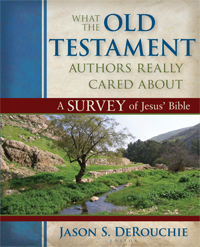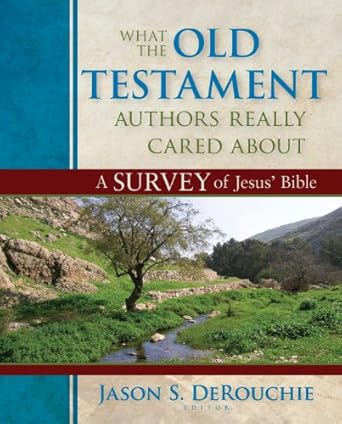Jason DeRouchie (PhD, The Southern Baptist Theological Seminary) is associate professor of Old Testament at Bethlehem College and Seminary and an active member of Bethlehem Baptist Church in Minneapolis, MN, where he resides with his wife and six children. He is a passionate teacher committed to helping Christians to exalt Jesus and to treasure the hope of the gospel from the Old Testament.
His new What the Old Testament Authors Really Cared About (Kregel, 2013) is a message-driven, gospel-saturated, theologically rich, multi-author, book-by-book, thematic survey of the Old Testament. It is written from a conservative, evangelical perspective, targeted toward college and seminary students and local churches, and designed to unpack the lasting message of the initial three-fourths of Christian Scripture.
In this new book Jason DeRouchie has charted something of a new direction for OT surveys. As all authors on books in this class DeRouchie wants the reader to see the OT “on its own terms,” of course. But unlike most others he is very concerned for us to see that on its own terms and rightly understood, the OT is a story — and specifically, it is about Jesus. The work is a team effort, with various chapters by other accomplished OT scholars, and besides his specific contributions in Leviticus, Deuteronomy, Kings, Ruth, and Ezra-Nehemiah DeRouchie provides a substantial introductory chapter displaying a big picture understanding of the OT, as well as introductions to each the Law, the Prophets, and the Writings and a number of helpful appendices — all of which combine to draw out a holistic view of “Jesus’ Bible.”
All told the book really is not just another OT survey, and so we asked Dr. DeRouchie to talk to us about his new work – which he does for us with delightfully informative detail!
Books At a Glance:
Please tell us what is unique about your book. What contribution were you attempting to make?
DeRouchie:
- Each chapter synthesizes in three to six themes the lasting message of each book.
- It is gospel-saturated and text-based, portraying the Old Testament as foundation for a fulfillment found in Christ and the New Testament and celebrating the hope of the Messiah and God’s kingdom as it is progressively disclosed.
- It has a different chapter for each book of Jesus’ Bible (Luke 24:44), following the Law-Prophets-Writings structure.
- It stresses the lasting relevance of the Old Testament through the text’s body and through over 160 sidebars the build bridges to the New Testament and the 21st century.
- Introductory issues (Who? When? Where? Why?) are condensed to one-page snapshots.
- It is a collaborative project, written by teachers with a proven ability to communicate the message of the Old Testament effectively.
- The clarity of the biblical message is enhanced through nearly 200 high-resolution photographs, over 80 charts and tables, and 12 color maps.
Books At a Glance:
Explain for us briefly something of your underlying convictions that directed you in your work — perhaps some specific biblical passages that capsulize your thinking and shaped your effort.
1. Nature and message. My first governing conviction is that the Old Testament provides foundation, whereas the New Testament supplies fulfillment. The Old Testament details the progressive development of God’s kingdom program that finds its completion only in Christ and the New Testament. The Old Testament is saturated with kingdom hope, but it ends demanding a sequel, with Jesus as its ultimate end and goal. Jesus himself believed that his Bible–the Old Testament–spoke of him (Luke 24:27; John 5:49, 46), anticipated “the good news of the kingdom of God” that he preached (Luke 4:43; Acts 1:3), would be completely fulfilled by him (Matt 5:17–18; Luke 24:44), and addressed a kingdom message addressing the Messiah and missions (Luke 24:46–47). Similarly, Paul viewed the Old Testament to convey a message about God’s kingdom that addressed the Messiah and the global call to the obedience of faith that his cross, resurrection, and ascension sparked (Acts 26:22–23; 28:23, 31; Rom 1:1–5).
Biblical interpreters must see the Old Testament relating to the New Testament much like an acorn relates to an oak tree. The latter grows out of the former, and the two inform one another (Matt 5:17–18; 11:13–14; Rom 1:1–5; Heb 11:13; 1 Pet 1:10–12). For the biblical theologian, the New Testament acts much like an answer key in the back of a math textbook; it provides a check to ensure we are correctly and fully interpreting all the equations, which in this case are found in the Old Testament. From a similar angle, we understand an author’s purpose best when we read the whole in light of the last chapter, which in Scripture means the New Testament. The church is built on the teaching of Christ and the apostles (Acts 2:42; Eph 2:20), and only in light of the inaugurated end-times fulfillment come in Christ can the Old Testament be fully understood as it was intended to be (Jer 31:2–3, 24; Isa 29:9–12; Dan 12:4, 9–10; 2 Cor 3:14; 1 Pet 1:12). With this in mind, my overview of the Old Testament message regularly moves to the New Testament to unpack the long-range trajectories that are evident.
2. Structure. I am increasingly convinced that in Scripture God gave us not only books but a book and that the arrangement of the Bible matters. That is, the Old Testament is less like a wall of various bolts of fabric and more like a quilt, with each square (i.e., book) having its own story, pattern, and colors (i.e., authorship, date, situation, and audience) but with a greater pattern being displayed when all are read together in their intentioned order. While Jesus’ Bible would have included the same books as our English Old Testaments, the New Testament suggests that it was arranged differently–structured in three parts (Law, Prophets, Writings) that began with Genesis, ended with Chronicles, and had Psalms as most dominant book of the third division (Luke 11:51; 24:44). Jesus saw the kingdom message of Messiah and missions disclosed most clearly through this structure (Luke 24:44–47), and at the very least, we will interpret the Old Testament most like Jesus and the apostles did if we read it in the order they followed.
Books At a Glance:
Your book is very fitting as a text for beginning students, and yet you follow the arrangement of books as they appear in the Jewish canon and not that of our English Bibles. Why did you follow this arrangement, and what insight does this afford?
DeRouchie: This survey was intended to help beginning students read the Old Testament more like Jesus and the apostles did–as a witness to the gospel of the kingdom focused on the Messiah and missions. To this end, I arranged the survey according to the Jewish three-part ordering, which appears to be the structure that Jesus and his first followers were using for teaching (Luke 11:51; 24:44; Acts 28:23). Two of the reasons that I have found the Jewish arrangement to be very theologically insightful and hope-filled are as follows:
1. The overarching organization of Jesus’ Bible is as follows: Law (narrative), Former Prophets (narrative), Latter Prophets (commentary), Former Writings (commentary), Latter Writings (narrative). This structure emphasizes in a way our English Bible ordering does not that the message of the Old Testament is framed by and only understood in light of the history of redemption–a continuous progression of divinely-ordained events all working together to magnify the glories of God’s Son. The same pattern is evident in the New Testament: Gospels (narrative), Acts (narrative), Paul’s epistles (commentary), Hebrews and General Epistles (commentary), Revelation (narrative [or sorts]). All of Scripture is held together by history–the kingdom story of God’s glory in Christ, and it must be read in this light.
2. The separation by means of “commentary” between the earlier narrative that ends in 1–2 Kings and the later narrative that begins with Daniel highlights the natural shift evident from the Prophets, which focus on Israel’s sin, to the Writings, which focus on kingdom hope. Jesus’ Bible did not end with the piercing darkness of the Major and Minor Prophets but with the rising sun of the hope-filled Writings. With this, Ruth is no longer seen as a mere positive counter to the dark trajectory set in Judges and continued in Samuel–Kings but is now viewed in light of prophetic promises (e.g., Mic 5:2) and as a positive Messianic prelude to the Writings that invites all the poetic books that follow to be read through a lens of Davidic kingdom hope. Similarly, a book like 1–2 Chronicles is read no longer as a mere restatement directly following 1–2 Kings but as a climactic, positive re-telling of Israel’s history that emphasizes the nation’s connection with God’s global purposes through Adam and the kingdom hope through the line of David. The Old Testament’s final words, “Let him go up” (2 Chr 36:23), become the natural bridge into “the book of the genealogy of Jesus Christ, the son of David, the son of Abraham” (Matt 1:1) and into a story of fulfilled salvation rising from Jerusalem and spreading to the ends of the earth.
Books At a Glance:
Taking that question just a bit further, some students have wondered why you do not follow the ordering of books found in the Massoretic Text but, it seems, the Babylonian Talmud, in which Ruth heads up the “Writings.” What is your reasoning for following this arrangement?
DeRouchie:
One of the challenges faced by those that see value in the Law-Prophets-Writings structure is in determining which listing of the Jewish canon one will follow. Building off the arguments of Roger Beckwith (The Old Testament Canon of the New Testament Church [Grand Rapids: Eerdmans, 1985], esp. 121–27, 152–53, 198) and Stephen G. Dempster (in a number of articles and essays), I chose to follow the most ancient complete listing of the Jewish canonical books found in Baba Bathra 14b. The arrangement aligns with the evidence of the New Testament and most likely dates well before its time. While this list is found in the Babylonian Talmud (ca. A.D. 500), it is located in a baraita that dates from around the time of the Mishnah (ca. A.D. 200) but was not included in it and which Beckwith has legitimately proposed finds its origin in a list drawn up by Judas Maccabaeus around 164 B.C. Dempster has employed this ordering in his excellent volume Dominion and Dynasty: A Biblical Theology of the Hebrew Bible (NSBT 15; Downers Grove, IL: InterVarsity, 2003).
Significantly, the arrangement found in the critical editions of the Hebrew Bible (BHS and BHQ) we use today is one of several arrangements witnessed to in medieval Jewish texts. The Tiberian Masoretic tradition found in the Aleppo Codex (A.D. 930) and the Leningrad Codex (A.D. 1009) places Chronicles before Psalms and ends the Old Testament with Ezra-Nehemiah. This ordering may have arisen due to anti-Christian bias, for while kingdom promises of a future were made, the Hebrew Scriptures are allowed to end without a driving sense of hope or need for a sequel. However, Jesus points to the illegitimacy of this ordering in Luke 11:51, where he appears to identify the first and last prophetic martyrs from a canonical rather than chronological perspective (“from the blood of Abel to the blood of Zechariah”). The last martyr mentioned in Chronicles is a certain Zechariah, who was killed in the temple court during the reign of Joash (835–796 B.C.; 2 Chr 24:20–21); however, the last chronological prophetic martyr was Uriah the son of Shemaiah, who died during the reign of Jehoiakim [609–598 B.C.; Jer 26:20–23]). Jesus’ Bible started with Genesis and ended with Chronicles.
In the last couple of decades, a number of very good evangelical surveys and theologies have simply followed the arrangement of the Jewish canon evidenced in the BHS, which has Psalms and Chronicles at the front and end of the Writings, respectively, and places Ruth after Proverbs and Esther before Daniel (e.g., Paul R. House, Old Testament Theology [Downers Grove, IL: InterVarsity, 1998]; William J. Dumbrell, The Faith of Israel: A Theological Survey of the Old Testament [2nd ed.; Grand Rapids: Baker, 2002]; Paul R. House and Eric Mitchell, Old Testament Survey [2nd ed.; Nashville: B&H, 2007]; James M. Hamilton Jr., God’s Glory in Salvation through Judgment: A Biblical Theology [Wheaton, IL: Crossway, 2010]). While very similar to the list found in Baba Barthra 14b, the arrangement derives from the medieval German Ashkenazi codices, which are quite late and themselves include a number of internal variations in the ordering of the Writings that may suggest a less-developed messianic, kingdom hope and an interpretive approach that treats canonical arrangement as more fluid and less intentioned.
In the end, I followed the listing Old Testament books in Baba Bathra 14b because it is the oldest we have, can easily be seen to align with the New Testament data, and appears to witness an elevated level of theological intentionality that supports the highly messianic, kingdom-focused reading of the New Testament. This stated, what seems most important to me is the three-part structure (Law, Prophets, Writings), the initial placement of Genesis and closing placement of 1–2 Chronicles, and the need to view the Writings in light of its most dominant book, the Psalms. All these features are themselves pointed to in the New Testament itself (Luke 11:51; 24:44; Acts 28:23).
Note:
Click here to see Part 2 of our interview with Dr.DeRouchie.


